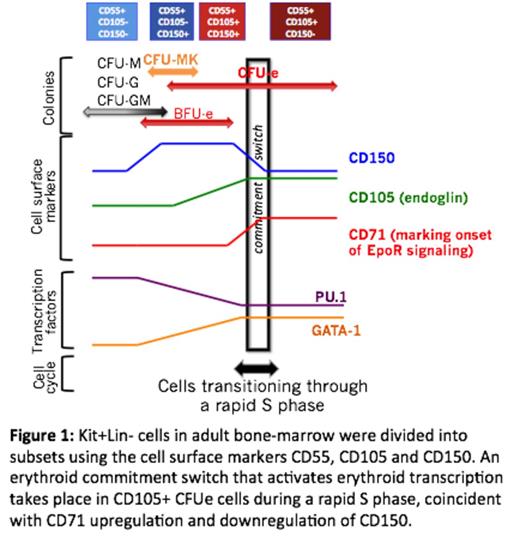Abstract
We previously characterized an S phase-dependent commitment switch in mouse fetal liver. Specifically, the upregulation of CD71 in the transition from Subset 0 (S0, Lin-CD71medium) to Subset 1 (S1, Lin-CD71high) identifies cells in early S phase of the last colony-forming-unit-erythroid (CFUe) generation, undergoing key differentiation events, including onset of Erythropoietin (Epo) dependence, GATA-1 activation and reconfiguration of chromatin at the §-globin locus control region. This commitment switch requires S phase progression, and is regulated by the S-phase- dependent downregulation of the transcription factor PU.1, a GATA-1 antagonist. Of note, the specific cell cycle S phase in which this commitment switch takes place differs from S phase in previous cycles, in that it is shorter, with a 50% faster rate of nucleotide incorporation into DNA.
Here, we investigate whether a similar commitment switch takes place in adult bone-marrow. Using fresh bone-marrow from mice in the basal state or following Epo injection, we determined colony-forming potential, transcriptional profiles and cell cycle status of Kit+Lin- subsets defined by cell surface markers that have been previously implicated as enriched in the megakaryocytic-erythrocytic lineages: CD105, CD150, CD55, CD71, in conjunction with a PU.1-GFP reporter mouse.
Using quantitative RT-PCR together with flow-cytometric analysis and the SPADE algorithm we identified a linear erythroid developmental sequence of Epo-responsive Kit+Lin-CD55+ bone-marrow subsets, which gradually declined in PU.1, transiently increased CD150, and upregulated both CD105 and CD71. The loss of PU.1 coincided with increased GATA1 levels and the transcriptional activation of erythroid genes. CFUe activity peaked within Kit+Lin-CD55+ cells that were also CD105+, where colonies of other lineage potential were rare (Fig 1).
Upregulation of CD71 in erythroid cells indicates the onset of Epo receptor signaling and Epo dependence. We found that in Kit+Lin-CD55+ bone-marrow in vivo, high levels of CD71 were highly correlated with S phase (Fig 2). Furthermore, the rate of incorporation of the nucleotide analogue BrdU was substantially higher in CD71 -high cells, suggesting a rapid, short S phase. To functionally examine the role of S phase, we isolated Kit+Lin-CD55+CD105+ cells that were CD71 low, and followed their differentiation in vitro. These cells upregulate CD71 within 10 to 16 hours, followed by upregulation of Ter119. Upregulation of CD71 was Epo dependent, and took place in S phase; further, it was reversibly inhibited by the DNA polymerase inhibitor, Aphidicolin, suggesting dependence on S phase progression.
We conclude that adult bone marrow Kit+Lin-CD55+CD105+ are at the CFUe developmental stage, and undergo an Epo and S-phase dependent commitment switch that activates the erythroid transcriptional and differentiation program. S phase during this commitment switch is characterized by a fast DNA synthesis rate.
No relevant conflicts of interest to declare.
Author notes
Asterisk with author names denotes non-ASH members.



This feature is available to Subscribers Only
Sign In or Create an Account Close Modal